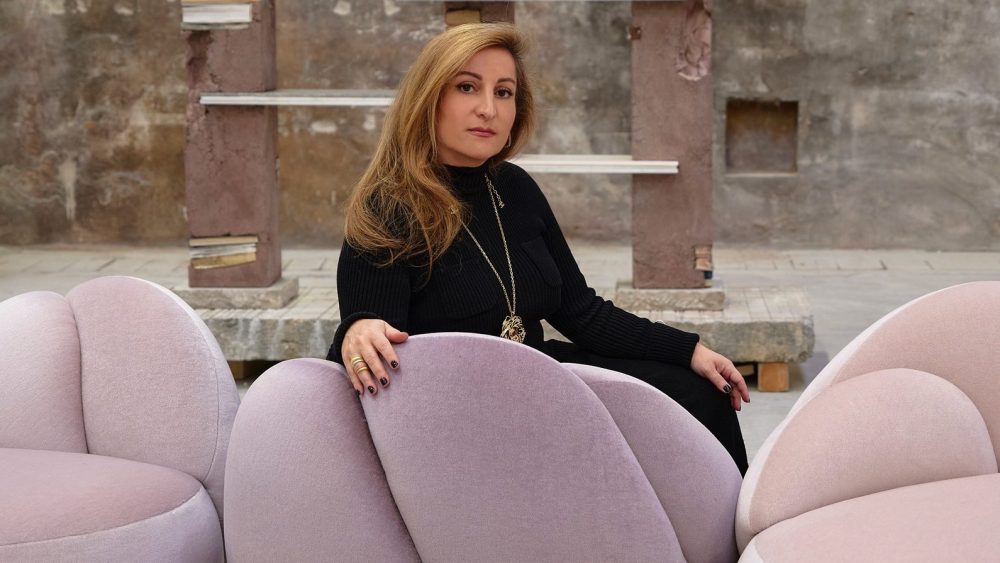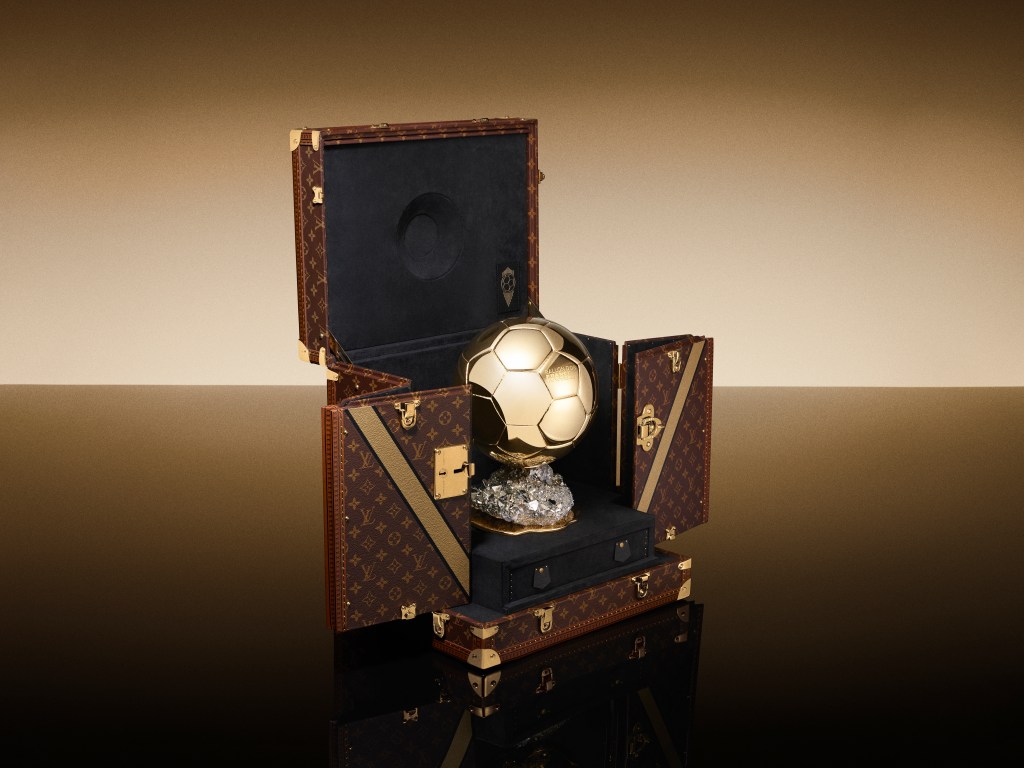MILAN — “The Power of Tenderness,” the name of a dreamy installation by Aline Asmar d’Amman at Milan Galleria Rossana Orlandi, set the tone for Milan Design Week. “Tenderness isn’t a sign of weakness, you know. It’s a sign of strength,” the Paris-based architect told WWD during a VIP dinner hosted with the doyenne of design Rosanna Orlandi.
The Lebanese-born visionary who was “bathed” in the poetry of 13th-century poet Rumi as a child most recently made waves for the Middle East’s first five-star train. And with Asmar d’Amman’s collectible furniture pieces here, it was evident that poetry remains very much at the heart of her work. Calling for softness through the poetry of design, bookends made of fragmented stone (part of her Béton Littéraire collection of bookshelves) struck a nostalgic chord. The lush Georgia lounge sofa and chairs called to mind life’s delights, while the pink and onyx tables highlighted nature’s enduring strength.
In and around the Salone del Mobile.Milano trade show and Milan Design Week that closed here Sunday, firms small and large challenged common modern design norms once dominated by strict geometries and bold colors. Without sacrificing quality and durability, brands issued a new message — a heartfelt homage to the world’s natural wonders, drawing us ever closer to Mother Nature, her phenomena and nuances.
You May Also Like
WWD compiled a list of designs that have enduring, poetic power:
Elisa Ossino’s Nereo for Salvatori

The art of sculpting marble into light forms dates back to ancient Rome and was perfected in divine glory by Renaissance and Baroque legends Michelangelo Buonarroti and Gianlorenzo Bernini. This season, Sicilian architect and designer Elisa Ossino unveiled Nereo, her new bathroom collection for stone specialist Salvatori. Interpreted natural stone through soft, majestic forms, sculpting marble into soothing shapes is still an artistic feat centuries later.
“Nereo takes its name from the Nereids, sea nymphs believed to live underwater. I wanted to create a bathroom for Salvatori where natural stone — such a precious material — was treated with both softness and grandeur, in bold forms and generous proportions, with a sensitivity that enhances the natural essence of the stone,” Ossino explained.
Available in a diverse array of marble including Bianco Carrara and Gris du Marais, its gentle curves call to mind wind and water’s effect on nature over time.
Knoll’s Biboni

Like a warm embrace, the anthropomorphic shape of Knoll’s Biboni sofa is defined by plush scallops and folds.
“It incorporates curvature that for us is quite friendly and also there’s a certain organicism, but it’s not in your face,” architect and designer Mark Lee told WWD at the Knoll stand during the Salone del Mobile.Milano trade show. Lee designed the marshmallow-looking sofa with Sharon Johnston who said the Biboni “wants to be a good friend.” Inspired by Eileen Gray’s Bibendum chair, designed in 1929 originating from the character created by Michelin to sell tires, the Biboni, covered in bouclé, has evolved this concept into a contemporary world seeking comfort away from the freneticism of everyday life. Biboni is a salute to the Michelin Man and his chubby folds, like his elbow. “It’s a portmanteau of two words. One is Bibendum and the other is macaroni, which stands for elbow pasta.”
Lauren Rottet for Atelier Vierkant and Turri

Celebrated architect, interior and furniture designer Lauren Rottet of Rottet Studio worked with Belgian firm Atelier Vierkant to create twin Split Face ceramic planters that combine sculptural form with natural shapes and hues. Known for her hospitality projects like St. Regis to Goldman Sachs and Viking Cruises, Rottet’s clients’ designs include a vast array of more than 50 hotels, restaurants, office buildings and luxury private residences across the world. This time she reminded the design set that she has a flair for the smaller details. In the heart of the upscale Quadrilatero district, she unveiled two larger-than-life, 7-foot planters in rounded forms and made with textured clay. Contemporized ever so slightly with gold reflective glaze the pieces were artfully arranged in the courtyard of Italian furniture firm Turri. Elsewhere, Rottet and Turri teamed up for a furniture collection of fresh pieces during Milan Design Week that ran the gamut from a sleek new desk to nostalgic lighting.
Giopato & Coombes

At the heart of the Cinque Vie neighborhood in Milan, Veneto-based firm Giopato & Coombes unfurled a sensory experience that showcased its expertise in creating technical objects that reflect organic shapes. Founded in 2014 in Treviso, a city in the Veneto region, the firm specializes in sculpted pieces. Its frosted Bolle (Italian for bubbles) mimics soft puffy clouds passing by in the sky and was showcased alongside its Scarabei (Italian for beetle) lighting, a profound investigation of living organisms, carefully sculpted to reflect natural propagation.
Gulla Jónsdóttir’s Ring Handle for Lualdi

Icelandic-born Gulla Jónsdóttir is known in the global design world for creating unexpected and poetic modern architecture and interior spaces. Eight years after she hit the Milan design scene with the sinuous Petal Chair, a sentimental salute to nature’s wonders, the Los Angeles-based designer made it back to Milan with another visionary design. This time she transformed an everyday piece like a door handle into a memorable experience, modeled in organic harmony. The Ring, made in collaboration with Italian firm Lualdi, was directly inspired by her collectible jewelry pieces. “It’s a curve that echoes the fluidity of nature. I aim to turn everyday elements into sculptural pieces,” she said, adding that Ring is part of her own personal expression. From entryways that invite touch to handles that feel like pieces of jewelry for a space, her designs seamlessly blend the worlds of architecture and art.
Rising Sun by Hechizoo, Nilufar

The Rising Sun suspension lamp covered in a weave of bronze and stainless steel threads lit the ephemeral vibe at Nilufar gallery on Via della Spiga aglow. Made by Hechizoo, a luxury textile atelier founded by self-taught weaver Jorge Lizarazo in 2000 in Bogotá, Colombia, its tubular form imbues contemporary and natural elements while its subtle shimmer emits calming light.
Parasite 2.0’s Poetic Brutalism

Combining elements from the urban and primal worlds, Milan-based architecture and design studio Parasite 2.0 showed the international crowd that the two can harmoniously coexist. During Milan Design Week, they teamed up with family-run marble and stone specialist Bianco67 for an unexpected collection: XC Milano. The capsule was designed specifically for Milanese hotspot Sandì, a restaurant located on Via Francesco Hayez, 13, situated on the north side of the city. An array of candle holders, vases, and side tables were crafted using reclaimed marble and stone and characterized by an innovative dry-joint system, that allows for the objects to be combined or juxtaposed in surprising ways.
The XC Milano collection follows the success of previous Parasite 2.0 capsule collections, including XC Objects and XC Miami which were showcased at Alcova Miami during Art Basel Miami 2025.

— With contributions by Andrea Onate



